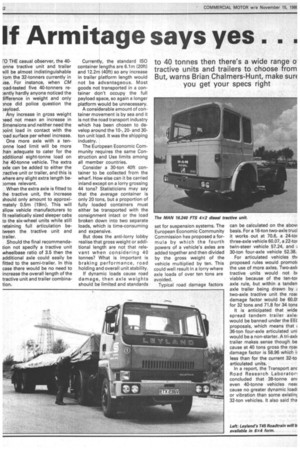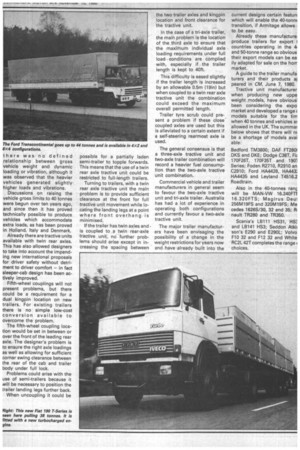If Armitage says yes . .
Page 44

Page 45

If you've noticed an error in this article please click here to report it so we can fix it.
FO THE casual observer, the 40onne tractive unit and trailer vill be almost indistinguishable rom the 32-tonners currently in Jse. For instance, when CM • oad-tested five 40-tonners re:ently hardly anyone noticed the lifference in weight and only )nce did police question the myload.
Any increase in gross weight leed not mean an increase in iimensions and neither need the )oint load in contact with the -oad surface per wheel increase.
One more axle with a ten:onne load limit will be more :han adequate to cater for the additional eight-tonne load on he 40-tonne vehicle. The extra axle can be added to either the :ractive unit or trailer, and this is tvhere any slight extra length be:.omes relevant.
When the extra axle is fitted to :he tractive unit, the increase should only amount to approxi-nately 0.5m (19in). This will allow vehicle manufacturers to fit realistically sized sleeper cabs to the six-wheel units while still retaining full articulation between the tractive unit and trailer.
Should the final recommendation not specify a tractive unit wheelbase ratio of 3.5 then the additional axle could easily be fitted to the semi-trailer. In this case there would be no need to increase the overall length of the tractive unit and trailer combination. Currently, the standard ISO container lengths are 6.1m (20ft) and 12.2m (40ft) so any increase in trailer platform length would not be advantageous. Most goods not transported in a container don't occupy the full payload space, so again a longer platform would be unnecessary.
A considerable amount of container movement is by sea and it is not the road transport industry which has been chosen to develop around the 10-, 20and 30ton unit load. It was the shipping industry.
The European Economic Community requires the same Construction and Use limits among all member countries.
Consider a 30-ton 40ft container to be collected from the wharf. How else can it be carried inland except on a lorry grossing 44 tons? Statisticians may say that the average container is only 20 tons, but a proportion of fully loaded containers must either be transported with the consignment intact or the load broken down into two separate loads, which is time-consuming and expensive.
But does the anti-lorry lobby realise that gross weight or additional length are not that relevant when considering 40 tonnes? What is important is braking performance, road holding and overall unit stability.
If dynamic loads cause road damage, then axle weights should be limited and standards set for suspension systems. The European Economic Community Commission has proposed a formula by which the fourth powers of a vehicle's axles are added together and then divided by the gross weight of the vehicle multiplied by ten. This could well result in a lorry where axle loads of over ten tons are avoided.
Typical road damage factors can be calculated on the al:Foy( basis. For a 16-ton two-axle trucl it works out at 70.6, a 24-tor three-axle vehicle 60.07, a 22-tor twin-steer vehicle 57.24, and r 30-ton four-axle vehicle 52.38.
For articulated vehicles th( proposed rules would promoti the use of more axles. Two-axli tractive units would not IN viable because of the ten-tor axle rule, but within a tanden axle trailer being drawn by two-axle tractive unit the roa( damage factor would be 60.0I for 32 tons and 71.8 for 34 tons It is anticipated that wide spread tandem trailer axle: would be banned under the EE( proposals, which means that 36-ton four-axle articulated uni would be a non-starter. A tri-axlr trailer makes sense though be cause at 40 tons gross the roa( damage factor is 58,96 which i! less than for the current 32-to articulated units.
In a report, the Transport anc Road Research Laborator) concluded that 38-tonne an( even 40-tonne vehicles nee( cause no greater dynamic loach or vibration than some existinc 32-ton vehicles. It also said tha
there was no defined relationship between gross vehicle weight and dynamic loading or vibration, although it was observed that the heavier vehicles generated slightly higher loads and vibrations.
Discussions on raising the vehicle gross limits to 40 tonnes were begun over ten years ago, and since then it has proved technically possible to produce vehicles which accommodate extra loads, as has been proved in Holland, Italy and Denmark.
Already there are tractive units available with twin rear axles. This has also allowed designers to take into account the impending new international proposals for driver safety without detriment to driver comfort — in fact sleeper-cab design has been actively improved.
Fifth-wheel couplings will not present problems, but there could be a requirement for a dual kingpin location on new trailers. For existing trailers there is no simple low-cost conversion available to overcome the problem.
The fifth-wheel coupling location would be set in between or over the front of the leading rear axle. The designer's problem is to ensure the right axle loadings as well as allowing for sufficient corner swing clearance between the rear of the cab and trailer body under full lock.
Problems could arise with the use of semi-trailers because it will be necessary to position the trailer landing legs further back.
When uncoupling it could be possible for a partially laden semi-trailer to topple forwards. This means that the use of a twin rear axle tractive unit could be restricted to full-length trailers.
Turning to trailers, with a twin rear axle tractive unit the main problem is to provide sufficient clearance at the front for full tractive unit movement while locating the landing legs at a point where front overhang is minimised.
If the trailer has twin axles and is coupled to a twin rear-axle tractive unit, no further problems should arise except in increasing the spacing between the two trailer axles and kingpin location and front clearance for the tractive unit.
In the case of a tri-axle trailer, the main problem is the location of the third axle to ensure that the maximum individual axle loading requirements under full load conditions are complied with, especially if the trailer length is kept to 40ft.
This difficulty is eased slightly if the trailer length is increased by an allowable 0.5m (19in) but when coupled to a twin rear axle tractive unit the combination could exceed the maximum overall permitted length.
Trailer tyre scrub could present a problem if these close coupled axles are used but this is alleviated to a certain extent if a self-steering rearmost axle is used.
The general consensus is that a three-axle tractive unit and two-axle trailer combination will record a heavier fuel consumption than the two-axle tractive unit combination.
Commercial vehicle and trailer manufacturers in general seem to favour the two-axle tractive unit and tri-axle trailer. Australia has had a lot of experience in operating both configurations and currently favour a two-axle tractive unit.
The major trailer manufacturers have been envisaging the possibility of a change in the weight restrictions for years now and have already built into the current designs certain featur( which will enable the 40-tonn( transition, if Armitage allows to be easy.
Already these manufacture produce trailers for export 1 countries operating in the 4. and 50-tonne range so obvious their export models can be ea ily adapted for sale on the horr market.
A guide to the trailer manufa turers and their products al peared in CM, June 7, 1980.
Tractive unit manufacturer when producing new uppe weight models, have obviousl been considering the expo market and developed a range ( models suitable for the tim when 40 tonnes and vehicles ar allowed in the UK. The summar below shows that there will n( be a shortage of models avai able: Bedford TM3800; DAF FT280r DKS and DKE; Dodge C38T, Fi 170F26T, 170F35T and 1901 Series; Foden R2710, R2910 an C2910; Ford HA4428, HA443: HA4435 and Leyland T4516.2 Roadtrain.
Also in the 40-tonnes ranc will be MAN-VW 16.240FTP 16.320FTS; Magirus Deui 256M19FS and 320M19FS; Me cedes 1626S/30, 32 and 35; 13, nault TR280 and TR350.
Scania's LB111 HS31, HS2 and LB141 HS3; Seddon Atkii son's E290 and E290L; Volvo F10 32 and F12 32 and White RC2L 42T completes the range ( choices.




























































































































